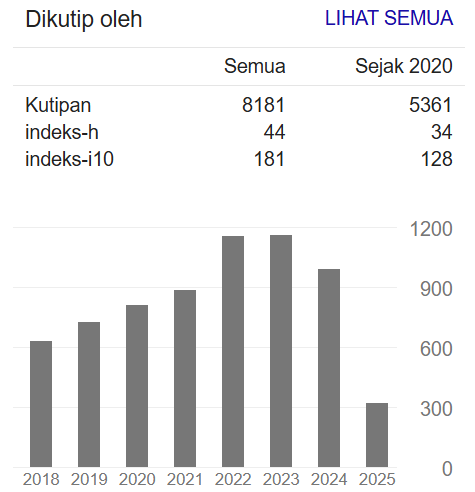PREOPERATIVE RISK FACTORS FOR SURGICAL SITE INFECTION FOLLOWING CESAREAN SECTION: A CASE-CONTROL STUDY
DOI:
https://doi.org/10.34011/jmp2k.v35i3.3337Keywords:
faktor risiko, infeksii daerah operasi, praoperasi, seksio sesareaAbstract
Infeksi daerah operasi (IDO) pascaseksio sesarea masih tinggi di Indonesia, termasuk di RSUP Dr. Hasan Sadikin Bandung. Angka kejadian IDO tahun 2022–2024 berkisar 2,34%–3,15%, melebihi standar nasional 2% dan target internal rumah sakit ≤1%, sehingga perlu perhatian terhadap faktor risikonya. Penelitian ini bertujuan untuk menganalisis hubungan faktor risiko praoperasi dengan kejadian infeksi daerah operasi pascaseksio sesarea di RSUP Dr. Hasan Sadikin Bandung. Penelitian ini menggunakan desain observasional analitik kasus-kontrol dengan ukuran sampel sebanyak 180 pasien (45 kasus dan 135 kontrol) yang menjalani seksio sesarea di rumah sakit tersebut dari Januari 2022 hingga Desember 2024, dipilih melalui teknik simple random sampling. Analisis univariat, bivariat (Chi-Square, Fisher’s Exact), dan multivariat (regresi logistik biner) dilakukan untuk menilai hubungan antara variabel independen dengan kejadian IDO. Analisis menunjukkan adanya hubungan signifikan antara kejadian IDO dengan variabel praoperasi seperti tipe operasi (p=0,035), usia (p=0,035), riwayat seksio sesarea (p=0,000), anemia (p=0,000), hipertensi (p=0,013), dan obesitas (p=0,047). Diabetes tidak menunjukkan hubungan signifikan dengan kejadian IDO (p=0,109). Analisis multivariat mengidentifikasi anemia (p=0,000), tipe operasi (p=0,006), riwayat seksio sesarea (p=0,009), usia (p=0,015), dan obesitas (p=0,030) sebagai faktor risiko paling dominan terhadap kejadian IDO. Hasil penelitian menekankan pentingnya penatalaksanaan dini terhadap faktor risiko praoperasi sebagai bagian dari strategi pencegahan IDO dan peningkatan mutu pelayanan kebidanan.
References
Kementerian Kesehatan RI, “Peraturan Menteri Kesehatan Republik Indonesia No.27 Tahun 2017,” May 2017. Accessed: Oct. 10, 2024. [Online]. Available: https://peraturan.bpk.go.id/Details/112075/permenkes-no-27-tahun-2017
World Health Organization (WHO), “Caesarean section rates continue to rise, amid growing inequalities in access,” World Health Organization (WHO). Accessed: Jun. 26, 2025. [Online]. Available: https://www.who.int/news/item/16-06-2021-caesarean-section-rates-continue-to-rise-amid-growing-inequalities-in-access
Departemen Obstetri dan Ginekologi RSUP Dr. Hasan Sadikin Bandung, “Sensus Persalinan RSUP Dr. Hasan Sadikin Bandung,” Bandung, 2024.
A. Gashaw, S. Fantu, and M. Tarekegn, “Factor associated with surgical site infection of women who undergone cesarean section in Hawassa University comprehensive specialized hospital southern Ethiopia, retrospective study design,” International Journal of Surgery Open, vol. 44, p. 100506, Jul. 2022, doi: 10.1016/j.ijso.2022.100506.
CDC, Ncezid, and DHQP, “Surgical Site Infection Event (SSI),” Jan. 2024. Accessed: Nov. 10, 2024. [Online]. Available: https://www.cdc.gov/nhsn/pdfs/pscmanual/9pscssicurrent.pdf
F. Chairani, I. Puspitasari, and R. H. Asdie, “Insidensi dan Faktor Risiko Infeksi Luka Operasi pada Bedah Obstetri dan Ginekologi di Rumah Sakit,” Jurnal Manajemen dan Pelayanan Farmasi (Journal of Management and Pharmacy Practice), vol. 9, no. 4, p. 274, Dec. 2019, doi: 10.22146/jmpf.48024.
I. Irawan, M. Rizkar Arev Sukarsa, and M. Alamsyah Aziz, “Pola Kuman dan Kepekaan Antibiotik pada Kasus Infeksi Luka Operasi Obstetri,” Indonesian Journal of Obstetrics & Gynecology Science, vol. 5, no. 1, pp. 2615–496, Mar. 2022.
Komite Pencegahan dan Pengendalian Infeksi RSUP Dr. Hasan Sadikin, “Laporan Healthcare-Associated Infections (HAIs) RSUP Dr. Hasan Sadikin,” Bandung, 2022.
Direktorat Jenderal Pelayanan Kesehatan Kementerian Kesehatan RI, “Laporan Akuntabilitas Kinerja Instansi Pemerintah RSUP Dr. Hasan Sadikin Bandung Tahun 2023,” 2024.
Ernest EC et al., “Reducing surgical site infections and mortality among obstetric surgical patients in Tanzania: A pre-evaluation and post-evaluation of a multicomponent safe surgery intervention. ,” BMJ Glob Health, vol. 6, no. 12, Dec. 2021, doi: doi:10.1136/bmjgh-2021-006788.
B. M. Gillespie et al., “Incidence and risk factors for surgical wound complications in women with body mass index >30 kg/m2 following cesarean delivery: a secondary analysis,” AJOG Global Reports, vol. 2, no. 3, Aug. 2022, doi: 10.1016/j.xagr.2022.100069.
B. Dieplinger et al., “Implementation of a comprehensive unit-based safety program to reduce surgical site infections in cesarean delivery,” Am J Infect Control, vol. 48, no. 4, pp. 386–390, Apr. 2020, doi: 10.1016/j.ajic.2020.01.016.
“Laporan Pasien Infeksi Daerah Operasi Ruang Alamanda A,” Bandung, 2022.
N. Islam et al., “Regional variations in incidence of surgical site infection and associated risk factors in women undergoing cesarean section: A systematic review and Meta-Analysis,” Intensive Crit Care Nurs, vol. 89, p. 103951, Aug. 2025, doi: 10.1016/j.iccn.2025.103951.
L. Guo, S. Huang, H. Sui, and W. Li, “Incidence and influencing factors for surgical site infections after cesarean section in China: A systematic review and meta‐analysis,” Journal of Obstetrics and Gynaecology Research, vol. 51, no. 1, Jan. 2025, doi: 10.1111/jog.16172.
S. B. . Hulley, S. R. . Cummings, W. S. . Browner, Deborah. Grady, and T. B. . Newman, Designing Clinical Research, 4th ed. Philadelphia: Wolters Kluwer Health/Lippincott Williams & Wilkins, 2013.
Setianingsih, S. Zukhri, and N. Indriani, “Faktor-Faktor Yang Mempengaruhi Kejadian Infeksi Daerah Operasi Pada Pasien Post Operasi Sectio Caesarea,” University Research Colloqium, no. The 12th, pp. 419–430, 2019.
T. Getaneh, A. Negesse, and G. Dessie, “Prevalence of surgical site infection and its associated factors after cesarean section in Ethiopia: systematic review and meta-analysis,” BMC Pregnancy Childbirth, vol. 20, pp. 1–11, 2020, doi: 10.1186/s12884-020-03005-8.
S. Wyawahare, J. Iravane, and C. Resident, “The Impact Of Anemia And Diabetes Mellitus On Surgical Wound Culture Outcomes In Patients Undergoing Lower Segment Cesarean Section (LSCS): A Cross-Sectional Study In Maharashtra, India,” International Journal of Medical Science and Current Research (IJMSCR), vol. 6, no. 2, pp. 958–964, Mar. 2023.
O. Ali, D. Kassahun, B. K. Rade, and A. Atnafu, “Maternal factors are important predictors for surgical site infection following cesarean section in Northwest Ethiopian,” Clin Epidemiol Glob Health, vol. 13, p. 100936, Jan. 2022, doi: 10.1016/j.cegh.2021.100936.
N. A. Korobkov, N. V. Bakulina, and N. S. Lodyagina, “Anemia of inflammation is a predictor of the progression of postoperative infection in obstetrics,” Herald of North-Western State Medical University named after I.I. Mechnikov, vol. 14, no. 4, pp. 53–61, Jan. 2023, doi: 10.17816/mechnikov114844.
L. Mendez-Pino, A. Zorrilla-Vaca, and D. L. Hepner, “Management of Preoperative Anemia,” Anesthesiol Clin, vol. 42, no. 1, pp. 65–73, Mar. 2024, doi: 10.1016/j.anclin.2023.09.002.
S. A. McNally, “Perioperative management of patients with anaemia: a new guideline,” Br J Hosp Med, vol. 84, no. 2, pp. 1–4, Feb. 2023, doi: 10.12968/hmed.2022.0552.
Ayesha, Nasreen, Shazia, Jawaria, and H. Rafique, “Risk Factors for Surgical Site Infection Following Cesarean Section,” Biological and Clinical Sciences Research Journal, vol. 2024, no. 1309, pp. 1–6, Nov. 2024, doi: 10.54112/bcsrj.v2024i1.1309.
F. Sattar, M. Siddiqa, A. Zahoor, U. Zahoor, A. Manzoor, and A. Zahoor, “Frequency of Wound Infections in Patients Undergoing Caesarean Section,” Pakistan Journal of Medical and Health Sciences, vol. 16, no. 5, pp. 805–807, May 2022, doi: 10.53350/pjmhs22165805.
Dr. S. Meena, Dr. P. Chouhan, Dr. R. Verma, and Dr. S. Bariya, “Paper on surgical site infections post cesarean section,” International Journal of Surgery Science, vol. 6, no. 1, pp. 233–237, Jan. 2022, doi: 10.33545/surgery.2022.v6.i1d.863.
H. Rubin et al., “Effectiveness of antimicrobial prophylaxis at 30 versus 60 min before cesarean delivery,” Sci Rep, vol. 11, no. 1, p. 8401, Apr. 2021, doi: 10.1038/s41598-021-87846-z.
K. Gomaa, A. R. Abdelraheim, S. El Gelany, E. M. Khalifa, A. M. Yousef, and H. Hassan, “Incidence, risk factors and management of post cesarean section surgical site infection (SSI) in a tertiary hospital in Egypt: a five year retrospective study,” BMC Pregnancy Childbirth, vol. 21, pp. 1–9, 2021, doi: 10.1186/s12884-021-04054-3.
M. Erritty et al., “Reduction of adverse outcomes from cesarean section by surgical‐site infection prevention care bundles in maternity,” International Journal of Gynecology & Obstetrics, vol. 161, no. 3, pp. 963–968, Jun. 2023, doi: 10.1002/ijgo.14605.
B. Filipović et al., “Enhanced Recovery After Surgery Protocols in Cesarean Delivery in International Settings: A Clinical Review of Implementation in Turkey and Croatia,” Surgeries, vol. 6, no. 1, p. 16, Feb. 2025, doi: 10.3390/surgeries6010016.
Ӧ. Tunçalp et al., “WHO Recommendations on Antenatal Care for A Positive Pregnancy Experience—Going Beyond Survival,” BJOG, vol. 124, no. 6, pp. 860–862, May 2017, doi: 10.1111/1471-0528.14599.
S. R. Bukhari, M. Gul, U. Asad, and L. Yusuf, “Risk Factors for Surgical Site Infection Following Cesarean Delivery,” Pakistan Journal of Medical and Health Sciences, vol. 16, no. 12, pp. 887–890, Nov. 2022, doi: 10.53350/pjmhs20221611887.
S. Dessu, S. Samuel, F. Gebremeskel, A. Basazin, Z. Tariku, and M. Markos, “Determinants of post cesarean section surgical site infection at public hospitals in Dire Dawa administration, Eastern Ethiopia: Case control study,” PLoS One, vol. 16, no. 4, p. e0250174, Apr. 2021, doi: 10.1371/journal.pone.0250174.
D. B. Ketema et al., “Incidence and predictors of surgical site infection following cesarean section in North-west Ethiopia: a prospective cohort study,” BMC Infect Dis, vol. 20, no. 1, p. 902, Dec. 2020, doi: 10.1186/s12879-020-05640-0.
C. Bernard, A. Agostini, F. Bretelle, J. Blanc, and A. Netter, “Risk factors and influence of surgical technique on the risk of caesarean scar defect formation: A systematic review of the literature,” J Gynecol Obstet Hum Reprod, vol. 54, no. 1, p. 102870, Jan. 2025, doi: 10.1016/j.jogoh.2024.102870.
D. Misra, V. Gautam, M. Faruqui, and M. Sen, “Barriers to Effective Wound Healing in Surgical Site Infection Following Cesarean Section,” Ann Afr Med, Apr. 2025, doi: 10.4103/aam.aam_189_24.
R. D. Wilson et al., “Guidelines for antenatal and preoperative care in cesarean delivery: Enhanced Recovery After Surgery Society recommendations (part 1)—2025 update,” Am J Obstet Gynecol, Apr. 2025, doi: 10.1016/j.ajog.2025.01.014.
S. Dessu, S. Samuel, F. Gebremeskel, A. Basazin, Z. Tariku, and M. Markos, “Determinants of post cesarean section surgical site infection at public hospitals in Dire Dawa administration, Eastern Ethiopia: Case control study,” PLoS One, vol. 16, no. 4, p. e0250174, 2021, doi: 10.1371/journal.pone.0250174.
Murniati, Zulkarnaini, and Z. Juwita, “Faktor-Faktor Yang Mempengaruhi Terjadinya Infeksi Luka Post Sectio Caesarea,” Darussalam Indonesian Journal of Nursing and Midwifery, no. 1, pp. 21–31, Sep. 2020.
Y. Dewi, C. Windiyaningsih, and A. Azis, “Determinan yang berpengaruh terhadap kejadian infeksi pada pasien sectio caesaria di Rumah Sakit Hermina Bekasi periode 2021 - 2022. ,” Jurnal Manajemen Dan Administrasi Rumah Sakit Indonesia (Marsi), vol. 7, no. 2, pp. 173–182, Apr. 2023, doi: DOI:10.52643/marsi.v7i2.3041.
S. Y. Karaca et al., “Identifying the Risk Factors Associated with Surgical Site Infection Following Cesarean Section in Adolescent Mothers,” J Pediatr Adolesc Gynecol, vol. 35, no. 4, pp. 472–477, Aug. 2022, doi: 10.1016/j.jpag.2021.12.021.
K. A. Khalid, A. F. M. Nawi, N. Zulkifli, Md. A. Barkat, and H. Hadi, “Aging and Wound Healing of the Skin: A Review of Clinical and Pathophysiological Hallmarks,” Life, vol. 12, no. 12, p. 2142, Dec. 2022, doi: 10.3390/life12122142.
Kementerian Kesehatan RI. Direktorat Jenderal Kesehatan Masyarakat, “Pedoman Pelayanan Antenatal Terpadu,” Jakarta, 2020.
Rosylianti, I. Puspita Sari, and R. Humardewayanti Asdie, “Faktor Risiko Infeksi Luka Operasi (ILO) dan Rasionalitas Antibiotik Profilaksis Bedah di RSUP Dr. Sardjito Yogyakarta,” | Majalah Farmaseutik, vol. 17, no. 3, pp. 265–274, 2021, doi: 10.22146/farmaseutik.v1i1.53094.
M. Erritty et al., “Evaluation of independent risk factors associated with surgical site infections from caesarean section,” Arch Gynecol Obstet, vol. 308, no. 6, pp. 1775–1783, Dec. 2023, doi: 10.1007/s00404-022-06885-7.
D. Frasca and N. Strbo, “Effects of Obesity on Infections with Emphasis on Skin Infections and Wound Healing,” Journal of Dermatology and Skin Science, vol. 4, no. 3, pp. 5–10, Aug. 2022, doi: 10.29245/2767-5092/2022/3.1157.
E. Ekanem, N. C. Ngene, J. Moodley, and J. Konje, “Prevention of surgical site infection and sepsis in pregnant obese women,” Best Pract Res Clin Obstet Gynaecol, vol. 91, p. 102406, Dec. 2023, doi: 10.1016/j.bpobgyn.2023.102406.
R. S. Legro et al., “Effects of preconception lifestyle intervention in infertile women with obesity: The FIT-PLESE randomized controlled trial,” PLoS Med, vol. 19, no. 1, p. e1003883, Jan. 2022, doi: 10.1371/journal.pmed.1003883.
E. Shacho, D. Yilma, A. T. Goshu, and A. Ambelu, “Incidence and risk factors of surgical site infection following cesarean section: a prospective cohort study at Jimma university medical center,” BMC Infect Dis, vol. 25, no. 1, p. 457, Apr. 2025, doi: 10.1186/s12879-025-10857-y.
Downloads
Published
How to Cite
Issue
Section
Citation Check
License
Copyright (c) 2025 Dedeh Supriyatin, Setyorini Irianti, Anita Deborah Anwar, Wiryawan Permadi, M. Rizkar Arev Sukarsa, Hadi Susiarno

This work is licensed under a Creative Commons Attribution-ShareAlike 4.0 International License.




